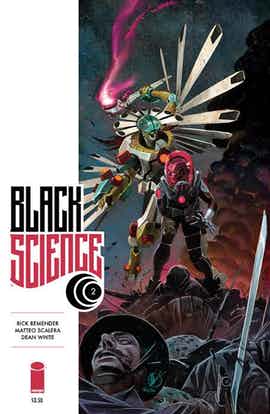
Though not as emotionally devastated as the first issue, the second installment of “Black Science” keeps the troubles coming and the adrenaline pumping for McKay and his crew. Remender is entirely at home in sci-fi universe(s), and it shows in his fluid, fast-paced storytelling. Scalera’s angular, inventive inks and White’s electric colors add immensely to this desperate, frantic vision of a scientist stumbling too fast into the future.
Having repaired the Pillar, instead of finding themselves home, the crew find themselves marooned for four hours in an alternate world at war. Here umpteenth-century-looking Native Americans have an army of early 20th-century-looking Germans utterly outgunned. Scalera manages to make the Americas’ futuristic costumes evocative and inventive without being terribly offensive, settling for a cool approach that looks like a prettier version of Gundam Wing.
Remender flips neatly between this futuristic fight and scenes from McKay’s past. The interplay between his shit-eating-grin days and his present provides both contrast and a sense of consequence. As he stated in the first issue, McKay’s in his current situation because of how he acted in the past. It’s smart to show the reader how the anarchist scientist became the father trying to save his children.
This issue also serves as the introduction to the crew’s villain, Kadir. Kadir is a familiar villain: the corporate schemer, the money man, the smart right arm of the establishment. In the past, he paid McKay and Rebecca’s salaries; in the present, he lords it over them. That said, he is at least a refreshingly practical Machiavel; he never prizes his pride above his survival. This makes him feel dangerous rather than dangerously incompetent. Scalera adds to his menace, having him issue his threats through a grotesque caricature of a grin.
The other crew members can feel a little thin or gimmicky — particularly Shawn, with his repeated use of terrible jokes — but they’re only just been fleshed out, and each offered at least a wide range of reactions to the present danger. Rage, terror, determination, humility — all of these emotions make an appearance, and the team isn’t constructed with a designated ‘idiot.’ It feels far more believable when every member of the team is actively trying to contribute to the group’s safety and survival. The plot thereby has a lot more suspense: will this character’s approach work? Who will end up saving the day? Will anyone? None of the solutions have a sense of inevitability. I’ll take that as a promise of coming complexity for the characters creating those solutions.
The art gives everything that genre art ought to, and the coloring and lettering play no small part in that effect. White injects electric blues and pinks into many of the scenes, summoning images of radioactive waste and other galaxies. His backgrounds are also imaginative. When the crew is hiding from the battle in a trench, he covers them in sickly grey-greens and dull yellows; when they’re in the lab, they’re lit by the green-blue of computer screens. On lettering, Wooton wisely chooses a hen-scratch-y font that looks like desperately written notes, perfectly complementing Scalera’s inks.
From the captions to the cliffhanger ending, this story feels full of life and possibility. I’ll be excited to revisit it next month.

